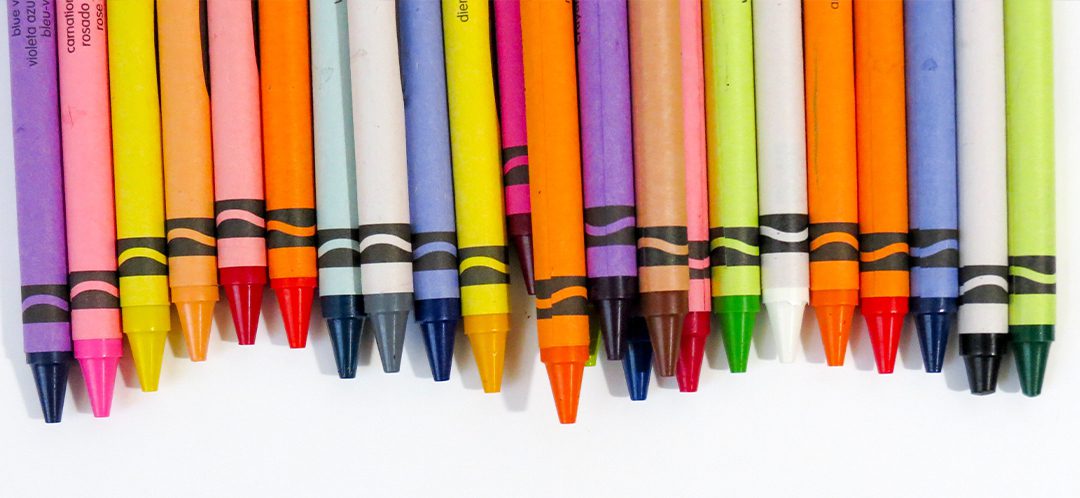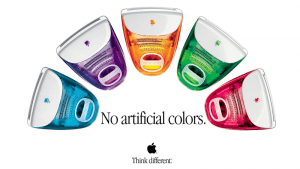Brand Colors and Pantone’s 2022 Color of the Year
PANTONE has released its color of the year and I must say that we at Cornerstone Creative are loving the selection. Very Peri is a throwback to the Crayoloa 64 box (with built-in sharpener) where Periwinkle was not just a role player crayon in row three, but rather a stalwart color that played a huge role in any kid’s coloring activity.
“As we move into a world of unprecedented change, the selection of PANTONE 17-3938 Very Peri brings a novel perspective and vision of the trusted and beloved blue color family, encompassing the qualities of the blues, yet at the same time with its violet red undertone PANTONE 17-3938 Very Peri displays a spritely, joyous attitude and dynamic presence that encourages courageous creativity and imaginative expressions.”
Moving on to professional pursuits…what’s in a color? Why is it so important to branding and how does color tap into our psyche and influence our emotions?
Consider the gold “smiling” arrow, a red cross, blue striped capital letters, a red bullseye, a black apple, and yellow arches. What brands come to mind? In each instance, color is the primary element used to identify an association with a brand. Color enables us to instantly recognize and draw emotional associations to a brand.
Effective and comprehensive brand strategy must consider the critical importance of color. Color is far more than an afterthought in the tool kit of components that make up brand identity and experience. Color is the very first perception customers will have with your brand, and it is an essential character in your brand’s story. When choosing a color to represent your brand, think far beyond your personal, subjective preferences.
Color And The Brain
Colors trigger a diverse set of responses within the brain and throughout the central nervous system. The proper perception of color has been one of the key drivers of human evolution. If color is that important to human evolution, just think how important it is to increasing the value of your brand.
Once we identify a color, we instantly have a chemical reaction in our brain that produces an emotional response. This triggers thoughts, memories and associations to people, places and events. Color affects us in profound ways. This all happens instantly and we aren’t even aware of it happening.
Middle School science class taught us color is the reflection of light waves picked up by your optic nerve, transmitted to your brain. Color doesn’t really exist; it’s only its reflection. We have all been predisposed and taught to give meanings and feelings to colors within the context of what the society values. These cultural associations to specific colors need to be a big driver of your strategic and creative decisions when forming the foundation of your brand’s identity in the marketplace.
Colors with long wavelengths (red for example) trigger the faster recognition response in the brain. While colors with shorter wavelengths (blue) are more soothing. They can lower pulse, respiration and blood pressure. It’s no accident that an healthcare brands like Cigna and United Health Care (among others) would have blue as the primary color it its visual identity system.
The same is true for other colors in the spectrum. Yellow is a middle wavelength color detected by the eye. Consequently yellow, because it is the brightest, commands attention more easily. It’s no coincidence road caution signs are yellow.
Colors Affect Mood And Emotion
Colors affect us in lots of ways, specifically they all create a specific mood. Color sets the mood of brand expression, and more importantly, creates mental associations to the meaning of your brand. So having people in the right mindset – mood – is critical when they encounter your brand.
John Deere owns green which means tractor. IBM has a royal blue, which means stability and reliability. Instagram chose two colors (orange and yellow) which means something important is here and needs your attention.
Color And Visual Identity
Color is foundational to the visual identity of your brand in all its expressions and executions–logos, packaging, products, digital communications, etc. UPS built their whole brand story around the proposition “what can brown do for you?” Apple transformed how we think of desktop computers through the creative use of color.
Selecting The Right Color For Your Brand
To convey a simple idea of meaning and differentiation requires you select a color that properly fits your strategic positioning. Selecting a color (and color scheme) for your brand must represent the emotional and tangible benefits of the brand. Certainly going up the brand pyramid color is essential to tying into the value proposition and brand promise..
Selecting the appropriate color to represent and differentiate your brand should be done thoughtfully. Here are three important considerations:
The Audience
Who are those people, what do they care about, what mood do they need to be in to engage with your brand? Different consumers are affected by color in different ways and cultural trends are always in transition. What color best anchors the meaning of your value to your audience and distinguishes your brand from the competition in the category?
The Archetype
If you have determined the appropriate archetype for your brand, what color best represents the attributes of the archetype? For example, if your brand archetype is the Explorer, you probably will consider colors that represent the outdoors or anything that is associated with the persona of that archetype. Red probably would not be a wise choice.
The Culture
Color means different things to people in different parts of the world, in different cultures. In the US, white represents purity, while in some regions of Asia it is the color of mourning. Color perceptions and meanings change with race, age, social class, gender and religion. The demographics and psychographics that are most dominate in the culture will be an important consideration in selecting the color that represents your brand in markets the brand serves.
Brass Tacks
Selecting colors to represent your brand should not just follow a current trend, or coolness, driven by the whims of your ad agency creative director or the personal taste of the owner of the business. Properly chosen colors define your brand’s value, strengthen and support your brand positioning, enable greater awareness and customer recall, and distinguish your brand among its alternatives. Picking the right color should never be underestimated.
If you want to know more about how color plays a critical role in your brand, or you’d like to start exploring ways to up your brand game, contact the branding experts at Cornerstone Creative workwithus@cornerstonecreative.com







